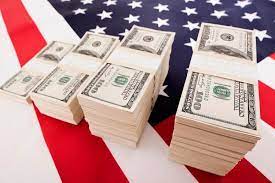The US Dollar: A Rollercoaster Ride Amid Economic Data and Fed Speculation
The US Dollar (USD) has been experiencing a volatile session this Wednesday, reaching new highs driven by remarks from Neel Kashkari, the President of the Federal Reserve (Fed) Bank of Minneapolis. Kashkari’s comments on Tuesday ignited market fluctuations when he suggested that a rate hike could still be on the table for this year. Despite the fact that Kashkari is a non-voting member this year, allowing him to speak more freely, and his indication that he does not foresee a rate hike as an immediate possibility, his remarks still managed to rattle the markets.
Economic Data Influences
Wednesday’s trading is heavily influenced by the release of the Richmond Fed Manufacturing Index for May. Earlier, the Dallas Fed Manufacturing Index fell further into negative territory, dropping to -19.4 in May from -14.5. If the Richmond Fed Index also shows a significant decline, it could signal further easing for the US Dollar, undermining any expectations of a rate hike spurred by Kashkari’s comments.
Key Economic Data Releases
- Mortgage Applications: At 11:00 GMT, the Mortgage Bankers Association reported a sharp decline in mortgage applications for the week ending May 24, falling by 5.7% after a positive 1.9% increase the previous week.
- Redbook Index: The Redbook Index, which tracks retail sales, showed an increase from 5.5% last week to 6.3% for the week ending May 24.
- Richmond Fed Manufacturing Index: Due at 14:00 GMT, the Richmond Fed Manufacturing Index for May is anticipated to show a slight improvement from -7 to -2. This release follows the Dallas Fed Manufacturing data’s steep decline, highlighting the sector’s ongoing struggles.
- US Treasury Auction: The Treasury will auction a 7-year Note around 17:00 GMT, an event that typically attracts significant market attention.
- Federal Reserve Comments: Federal Reserve Bank of New York President John Williams will participate in a roundtable discussion with local leaders at 17:45 GMT, while the Fed’s Beige Book is scheduled for release at 18:00 GMT. Additionally, Atlanta Fed President Raphael Bostic will speak at 23:00 GMT at the Annual AEA Conference on Teaching and Research in Economic Education, providing further insights into the Fed’s outlook.
Market Sentiment and Reactions
Equity markets are reflecting a cautious sentiment, with both US and European stocks sliding by about 1%. According to the CME FedWatch Tool, the probability of maintaining current interest rates in September stands at 53.7%. In contrast, there’s a 41.7% chance of a 25 basis points (bps) rate cut and a 4.1% likelihood of a 50 bps rate cut. Despite Kashkari’s comments, the market has only priced in a marginal 0.5% chance of a rate hike.
The benchmark 10-year US Treasury Note yield remains elevated at around 4.56%, marking a peak for the week.
US Dollar Index Technical Analysis
The US Dollar Index (DXY) displayed significant movement on Tuesday, testing its lower support levels. The 100-day Simple Moving Average (SMA) at approximately 104.34 played a crucial role in reversing the DXY’s downward trend, pushing it back above 104.50. However, the sustainability of this rebound is in question, with attention turning to upcoming economic data releases, including the Q1 US Gross Domestic Product (GDP) second estimate on Thursday and the Personal Consumption Expenditures (PCE) Price Index for April on Friday.
Key Levels to Watch
- Upside: The DXY needs to reclaim the 55-day SMA, currently at 104.82, and the psychological level of 105.00. Further resistance points are at 105.12 and 105.52.
- Downside: Support levels include the 200-day SMA at 104.42 and the 100-day SMA around 104.34. A break below these levels could lead to a drop towards 103.00, with significant support at the March low of 102.35 and the December low of 100.62.
Conclusion
The US Dollar’s recent rally, fueled by speculative comments from a non-voting Fed member and a mix of economic data releases, underscores the market’s sensitivity to potential interest rate changes and economic indicators. As traders navigate through the week’s remaining economic events, the USD’s trajectory remains uncertain, hinged on data outcomes and further communications from Fed officials. This dynamic landscape illustrates the intricate interplay between monetary policy speculation and economic performance, keeping traders on their toes as they adapt to each new development.
